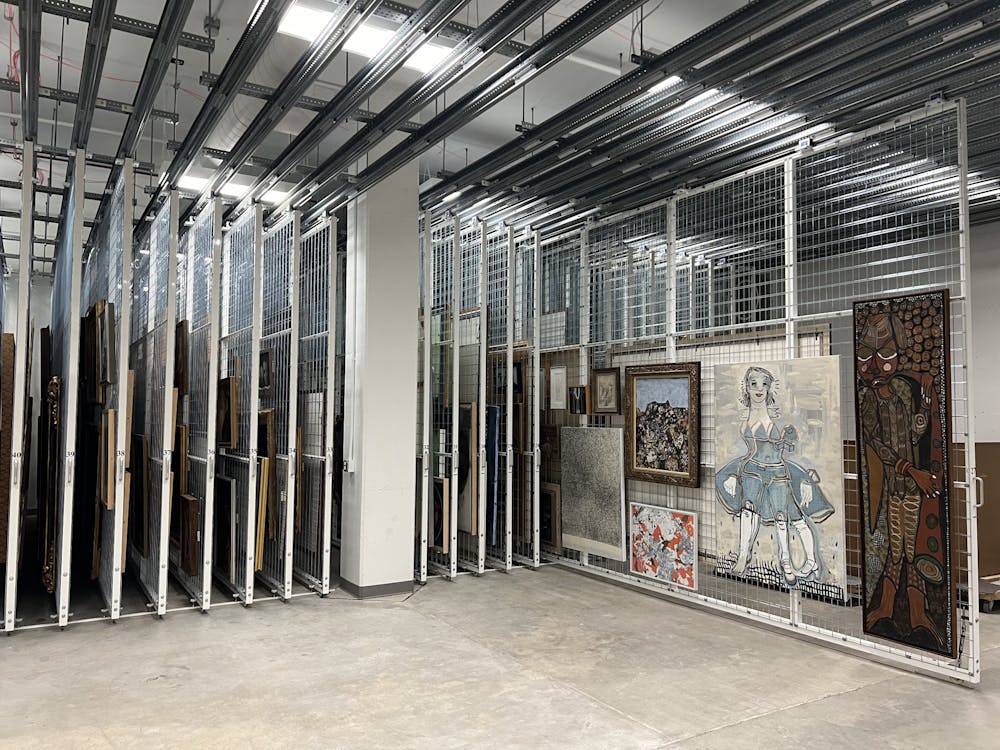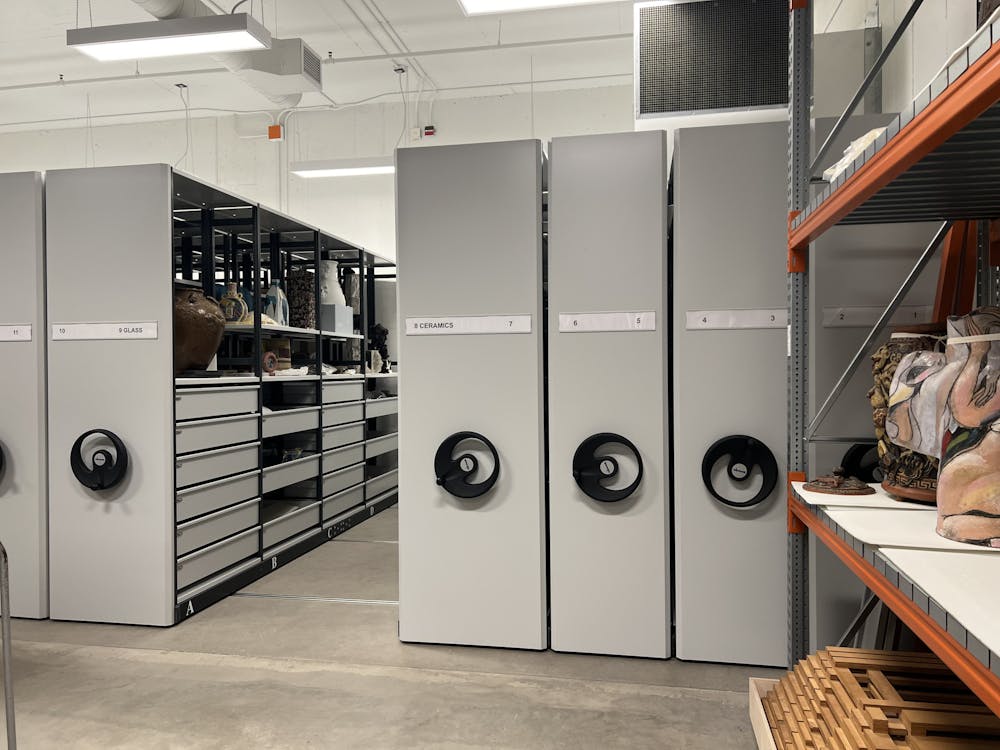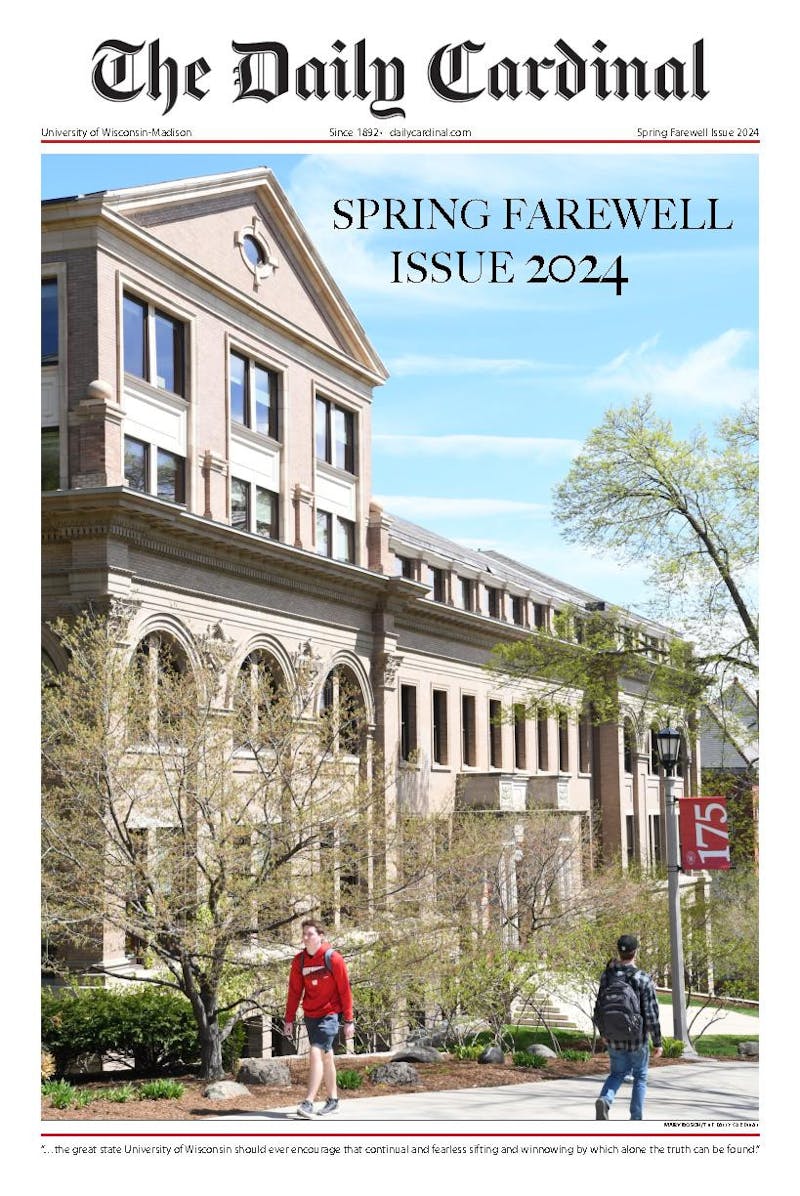The Chazen occupies a paradoxical space on the University of Wisconsin-Madison campus, wavering between its status as a hidden gem and a well-known tool used to rope prospective students into enrolling. On any given day, there might be a tour group huddled together in the lobby or a long line at the cafe.
Yet, these groups barely venture beyond the first floor to upstairs exhibit areas teeming with art.
Until the last few days of my freshman year, I was one of the people who’d never fully explored the Chazen. And even my discovery was made because I was showing it off to a family member in town.
For wandering eyes perusing the Chazen’s less than 1,500 items currently on view, it’s hard to imagine there are any unseen pieces left in the museum.
Spoiler alert: There are around 23,500 of them.
Those 23,500 pieces reside in the Chazen’s storage, a spot unknown even to most who browse the Chazen’s upper floors. The storage space consists of separate rooms where the art lays dormant and is cared for when not on view.
Last October, I took a tour around the storage area to highlight the people, processes and pieces that upkeep the Chazen’s prized possesions.
Canvassing the storage rooms
One of the first things that stood out when Exhibition and Collection Project Manager Kate Wanberg and I first entered the storage room were large, black sculptures that reside on the shelves facing the doors. Wanberg told me they are part of a larger piece, one with many moving parts that requires precise display.
The piece is called “Rhyme,” by Tenmyouya Hisashi, and it came with two large illustrations: black boulders and about two tons of red sand to be raked like a Japanese sand garden.
“This is one of those installation pieces where you never see the whole thing together until it's actually in the gallery,” she said. “You don't really get a full sense of the object just from storage.”
This is the position most stored art pieces find themselves in: condensed and disjointed.

Some of the larger paintings in the room are hung on large, rollout racks designed to maximize the amount of art kept in one room. One in particular stood out: a large, 60- by 84-inch painting that stands out against the gray walls of the room. The painting is dominated by a dark, empty museum room. However, in the next room over, there appears to be natural light which floods into the room. Like a black hole, it commands your attention.
There’s no title, but the piece is from 2002 by David Klamen, who had an exhibit in the Elvehjem dedicated to his works in 2004 and 2005.
Many of the larger paintings are stored on these rolling racks. But others, like sculptures, need to be stored based on their unique shape. As we walked around another storage room, Wanberg highlighted one sculpture as an example.
It’s a statue of a young girl with her hands braced on her knees. When fully assembled, the piece — “Flower Girl,” by Cynthia Consentino — portrays the girl vomiting up flowers. There are more than five parts to the piece, all of which are stored separately near the largest piece, the statue of the girl. She leans forward, braced to protect herself in storage, though there is a plastic piece in front of her to prevent the girl from falling if she were to tip forward.
Wanberg said many of the pieces in storage have their own protection systems designed to ward off signs of age and to prevent damage.
“Some things will get really specific storage mounts to protect them,” Wanberg said. “We have to think about creating and fabricating things to keep them safe.”
As she opened one of the moving cabinets, she showed me a piece that is usually displayed standing up but was laid down for storage. Wanberg said museum staff built an elaborate, custom-fitting casing with acid-free materials to protect the paint and prevent cracks in the wood.
“Every time we put an object into storage, there's the consideration of how would we display this versus how would we store it?” she said.
Pa-per view
Over in the Works on Paper storage area, Chazen Academic Coordinator Mieke Miller had to peel a thin layer of wax paper off of every piece. The paper prevents dust or any other unwanted particles from settling on the art and potentially harming it.
Like the Works on Paper room, each storage area has specific climate conditions meant to facilitate art preservation. Everything in the space is humidity- and temperature-controlled, and the lights are usually off to prevent pigment fading.
As we walked around the room, Wanberg and I stumbled onto a cart with brushes of all shapes and sizes, among other tools. In her job, alongside overseeing installations and preparing artwork for display, she also helps take care of items in storage. The items on the cart, she told me, are for preservation, often confused with conservation.
“Preservation methods are thinking about how we care for the object without really doing anything permanent,” she said. “It’s nonaggressive techniques that are just going to promote the well-being of the artwork.”
Conservation, on the other hand, utilizes chemical processes to restore art and is a more “drastic” method of preserving art.
“If you've ever seen the videos of conservationists removing varnish with q-tips and allowing the brightness of the painting to shine through once again, that's conservation,” Wanberg said. “This process, however, is often performed externally to museums at labs that have the correct training, tools and chemicals to execute the process.”
These pieces can make their way out of storage, though briefly, for academic visits. Miller often coordinates with professors or teaching assistants to create short programs for students to come in and analyze relevant artwork. It’s an exercise in critical thinking but also a display of the depth of the Chazen’s collection.
During one of these visits, Miller brought out a print with bright colors and graphic outlines that deeply contrasted its subject matter. “American Guardian,” by Roger Shimomura, depicts a sniper perched in a tree with his gun by his side and his binoculars focused on a small child riding a tricycle. The vivid colors and art style evoke pop art and graphic novel illustration styles of the 1950s.
In the background, however, lies a guard tower, and a barbed-wire fence surrounds the neighborhood in which the boy plays. An educated guess and a Google search soon land you at the realization that Shimomura was drawing off of his own childhood in a Japanese internment camp during World War II.
The context of this piece brings a whole new meaning and another level of analysis, something Miller said she loves seeing students experience. She tries to pull diverse works for student viewing, opting away from all-white male European artists and instead toward showing works from all continents and walks of life.
“While [demographics] doesn't always apply to the discussions the students choose to have, that's something important to me,” Miller said. “It wouldn't be an accurate reflection of the Chazen’s collection otherwise.”
Miller, who has a master’s degree in art history, recalled writing her master’s thesis on an engraving of the story of Adam and Eve by Albrecht Dürer and then later discovering a print of it was in the Drawing and Prints storage at the Chazen.
She said the Chazen’s sheer amount of art — and the fact that students are able to see the pieces through class meetings in the study room —- is a monument to academic curiosity and the desire to learn.
“As an academic teaching museum, we need to preserve things for the future, but we also want to make everything as accessible to our audience as possible,” Miller said. “Which is why having [the study room] is great.”
These pieces, despite being in storage, exist for those who ask.
Annika Bereny is the Special Pages Editor for the Daily Cardinal and specializes in state news and politics reporting. Follow her on Twitter at @annikabereny.






